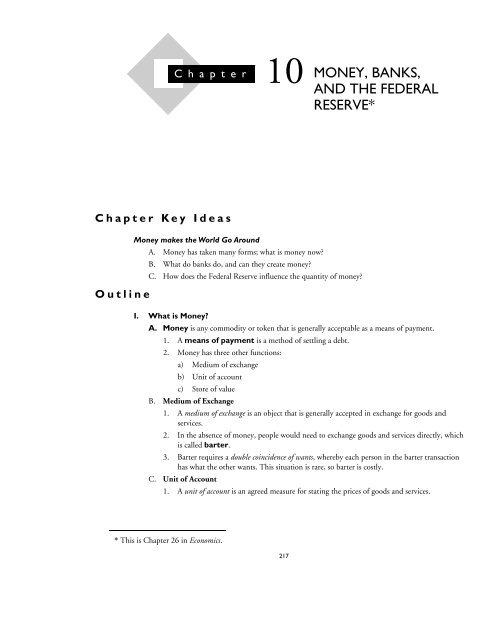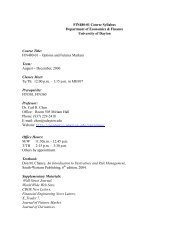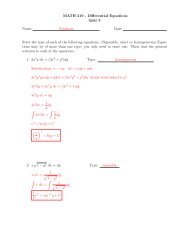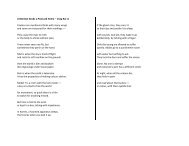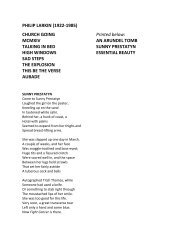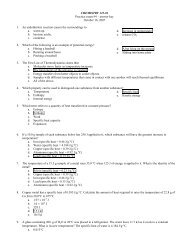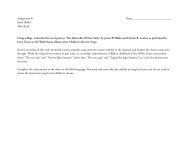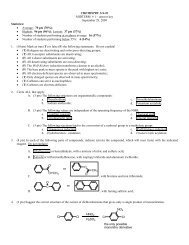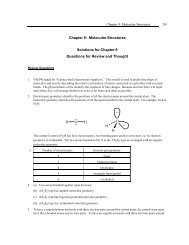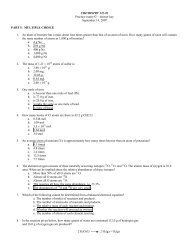Chap 26
Chap 26
Chap 26
Create successful ePaper yourself
Turn your PDF publications into a flip-book with our unique Google optimized e-Paper software.
<strong>Chap</strong>ter Key Ideas<br />
Outline<br />
C h a p t e r<br />
* * This is <strong>Chap</strong>ter <strong>26</strong> in Economics.<br />
10<br />
Money makes the World Go Around<br />
A. Money has taken many forms; what is money now?<br />
B. What do banks do, and can they create money?<br />
C. How does the Federal Reserve influence the quantity of money?<br />
217<br />
MONEY, BANKS,<br />
AND THE FEDERAL<br />
RESERVE* *<br />
I. What is Money?<br />
A. Money is any commodity or token that is generally acceptable as a means of payment.<br />
1. A means of payment is a method of settling a debt.<br />
2. Money has three other functions:<br />
a) Medium of exchange<br />
b) Unit of account<br />
c) Store of value<br />
B. Medium of Exchange<br />
1. A medium of exchange is an object that is generally accepted in exchange for goods and<br />
services.<br />
2. In the absence of money, people would need to exchange goods and services directly, which<br />
is called barter.<br />
3. Barter requires a double coincidence of wants, whereby each person in the barter transaction<br />
has what the other wants. This situation is rare, so barter is costly.<br />
C. Unit of Account<br />
1. A unit of account is an agreed measure for stating the prices of goods and services.
218 CHAPTER 10<br />
2. Table 10.1 illustrates how a unit of<br />
account simplifies price<br />
comparisons.<br />
D. Store of Value<br />
As a store of value, money can be held for<br />
a time and later exchanged for goods and<br />
services.<br />
E. Money in the United States Today<br />
1. Money in the United States consists<br />
of bills and coins—called<br />
currency—and deposits at banks<br />
and other depository institutions.<br />
2. The two main official measures of money in the United States are M1 and M2.<br />
3. M1 consists of currency outside of banks, traveler’s checks, and checking deposits owned by<br />
individuals and businesses.<br />
4. M2 consists of M1 plus time deposits, savings deposits, and money market mutual funds<br />
and other deposits.<br />
5. Figure 10.1 graphically illustrates<br />
the composition of these two<br />
measures in 2003 and shows the<br />
relative magnitudes of the<br />
components of money.<br />
6. The items in M1 clearly meet the<br />
definition of money; the items in<br />
M2 do not do so quite so clearly<br />
but still are quite liquid. Liquidity<br />
is the property of being instantly<br />
convertible into a means of<br />
payment with little loss in value.<br />
7. Checkable deposits are money, but<br />
checks are not; checks merely are<br />
the means by which the money is<br />
transferred among people.<br />
8. Credit cards are not money. Credit<br />
cards enable the holder to obtain a<br />
loan quickly, but ultimately the<br />
loan must be repaid with money.<br />
II. Depository Institutions<br />
A. A depository institution is a firm that takes deposits from households and firms and makes<br />
loans to other households and firms. The deposits of three types of depository institution make<br />
up the nation’s money:<br />
1. Commercial banks<br />
2. Thrift institutions<br />
3. Money market mutual funds
MONEY, BANKS, AND THE FEDERAL RESERVE 219<br />
B. Commercial Banks<br />
1. A commercial bank is a firm that is licensed by the Comptroller of the Currency or by a<br />
state agency to receive deposits and make loans.<br />
2. Table 10.2 shows the aggregate<br />
balance sheet of the commercial<br />
banks in the United States at the<br />
end of June 2003.<br />
3. A commercial bank’s balance sheet<br />
summarizes its business and lists the<br />
bank’s assets, liabilities, and net<br />
worth.<br />
4. The objective of a commercial bank<br />
is to maximize the net worth of its<br />
stockholders.<br />
5. To achieve this objective, banks make risky loans at a higher interest rate than the interest<br />
rate they pay on deposits.<br />
6. But the banks must balance profit and prudence; loans generate profit, but depositors must<br />
be able to obtain their funds when they want them.<br />
7. So banks divide their funds into two parts: reserves and loans.<br />
8. Reserves are the cash in a bank’s vault and deposits at Federal Reserve Banks.<br />
9. Bank lending takes the form of liquid assets, investment securities, and loans.<br />
C. Thrift Institutions<br />
1. The thrift institutions are savings and loan associations, savings banks, and credit<br />
unions.<br />
2. A savings and loan association (S&L) is a depository institution that receives checking<br />
and savings deposits and that makes personal, commercial, and home-purchase loans.<br />
3. A savings bank is a depository institution that accepts savings deposits and makes mainly<br />
mortgage loans.<br />
4. A credit union is a depository institution owned by a social or economic group such as a<br />
firm’s employees that accepts savings deposits and makes mostly consumer loans.<br />
D. Money Market Mutual Funds<br />
A money market fund is a fund operated by a financial institution that sells shares in the<br />
fund and holds liquid assets such as U.S. Treasury bills or short-term commercial paper.<br />
E. The Economic Functions of Depository Institutions<br />
1. Depository institutions make a profit from the spread between the interest rate they pay on<br />
their deposits and the interest rate they charge on their loans.<br />
2. Depository institutions provide four main types of services:<br />
a) Create liquidity by accepting deposits that can be withdrawn instantly and using these<br />
deposits to make long-term loans.<br />
b) Minimize the cost of obtaining funds by pooling many people’s relatively small deposits<br />
into large sums that can be loaned to many borrowers.<br />
c) Minimize the cost of monitoring borrowers by specializing in this activity.<br />
d) Pool risk by lending to many different borrowers so that if one borrower is unable to<br />
pay back the loan the lender loses only a small fraction of total deposits.
220 CHAPTER 10<br />
F. Financial Regulation, Deregulation, and Innovation<br />
1. Depository institutions face two types of regulations: deposit insurance and balance sheet<br />
rules.<br />
2. Deposits at banks, S&Ls, savings banks, and credit unions are insured by the Federal<br />
Deposit Insurance Corporation (FDIC).<br />
a) This insurance guarantees deposits of up to $100,000.<br />
b) Banks benefit from deposit insurance because the risk of a bank run is minimized.<br />
c) This guarantee gives depository institutions the incentive to make risky loans because<br />
the depositors believe their funds to be perfectly safe; because of this incentive balance<br />
sheet regulations have been established.<br />
3. There are four main balance sheet rules:<br />
a) Equity capital requirements — regulations setting the minimum amount of the owners’<br />
financial wealth that must be at stake in the depository institution.<br />
b) Reserve requirements — rules listing the minimum percentages of deposits that must be<br />
held in currency or in other safe assets.<br />
c) Deposit rules — restrictions on the type of deposits that an intermediary may accept.<br />
d) Lending rules — restrictions on the type and size of loans that can be made by a<br />
depository institution.<br />
G. Deregulation in the 1980s and 1990s<br />
1. The 1980s were marked by considerable financial deregulation, when federal legislation and<br />
rule changes lifted many of the restrictions on depository institutions, removing many of<br />
the distinctions between banks and others, and strengthening the control of the Federal<br />
Reserve over the system.<br />
2. In 1994 the Riegle-Neal Interstate Banking and Branching Efficiency Act was passed, which<br />
permits U.S. banks to establish branches in any state. It led to a wave of mergers.<br />
H. Financial Innovation<br />
1. The 1980s and 1990s have been marked by financial innovation—the development of<br />
new financial products aimed at lowering the cost of making loans or at raising the return<br />
on lending.<br />
2. Financial innovation occurred for three reasons:<br />
a) The economic environment, especially of the 1980s, featured high inflation and high<br />
interest rates, which created risk for intermediaries. Some innovations, such as variable<br />
rate mortgages, were aimed at lowering this risk.<br />
b) Massive technological change, especially reductions in the cost of computing and longdistance<br />
communication, brought other innovations.<br />
c) Much innovation was directed at avoiding regulation.<br />
I. Deregulation, Innovation, and Money<br />
The combination of deregulation and innovation has produced large changes in the composition<br />
of money, both M1 and M2.<br />
III. How Banks Create Money<br />
A. Reserves: Actual and Required<br />
1. The fraction of a bank’s total deposits held as reserves is the reserve ratio.
MONEY, BANKS, AND THE FEDERAL RESERVE 221<br />
2. The required reserve ratio is the ratio of reserves to deposits that banks are required,<br />
by regulation, to hold. A bank’s required reserves are equal to its deposits multiplied by the<br />
required reserve ratio.<br />
3. Excess reserves equal actual reserves minus required reserves.<br />
B. Creating Deposits by Making Loans<br />
1. When a bank receives a deposit of currency, its reserves increase by the amount deposited,<br />
but its required reserves increase by only a fraction (determined by the required reserve<br />
ratio) of the amount deposited.<br />
2. The bank has excess reserves, which it loans. These loans can end up as deposits in another<br />
bank in the banking system. The new bank behaves the same as the previous bank (loaning<br />
the excess reserves) but has a smaller amount of excess reserves.<br />
3. The process continues until the banking system has created enough deposits to eliminate its<br />
excess reserves.<br />
3. Figure 10.2 illustrates this process when banks keep 25 percent of a deposit as reserves.<br />
IV. The Federal Reserve System<br />
A. The Federal Reserve System, or the Fed, is the central bank of the United States. A<br />
central bank is a bank’s bank and a public authority that regulates a nation’s depository<br />
institutions and controls the quantity of money.<br />
B. The Fed’s Goals and Targets<br />
1. The Fed conducts the nation’s monetary policy, which means that it adjusts the quantity<br />
of money in circulation.
222 CHAPTER 10<br />
2. The Fed’s goals are to keep inflation in check, maintain full employment, moderate the<br />
business cycle, and contribute toward achieving long-term growth.<br />
3. In pursuit of its goals, the Fed pays close attention to interest rates and sets a target that is<br />
consistent with its goals for the federal funds rate, which is the interest rate that the<br />
banks charge each other on overnight loans of reserves.<br />
C. The Structure of the Fed<br />
1. The key elements in the structure of the Fed are the Board of Governors, the regional<br />
Federal Reserve banks, and the Federal Open Market Committee.<br />
2. The Board of Governors has seven members appointed by the president of the United States<br />
and confirmed by the Senate. Board terms are for 14 years and overlap so that one position<br />
becomes vacant every 2 years. The president appoints one member to a (renewable) fouryear<br />
term as chairman.<br />
3. Each of the 12 Federal Reserve Regional Banks has a nine-person board of directors and a<br />
president. Figure 10.3 shows the regions of the Federal Reserve System.<br />
4. The Federal Open Market Committee (FOMC) is the main policy-making group of<br />
the Federal Reserve System. It consists of the members of the Board of Governors, the<br />
president of the Federal Reserve Bank of New York, and the 11 presidents of other regional<br />
Federal Reserve banks of whom, on a rotating basis, 4 are voting members. The FOMC<br />
meets every six weeks to formulate monetary policy.
MONEY, BANKS, AND THE FEDERAL RESERVE 223<br />
5. Figure 10.4 summarizes the Fed’s<br />
structure and policy tools.<br />
D. The Fed’s Power Center<br />
1. In practice, the chairman of the Board<br />
of Governors (since 1987 Alan<br />
Greenspan) is the center of power in<br />
the Fed.<br />
2. The chairman controls the agenda of<br />
the Board, has better contact with the<br />
Fed’s staff, and is the Fed’s<br />
spokesperson and point of contact with<br />
the federal government and with<br />
foreign central banks and governments.<br />
E. The Fed’s Policy Tools<br />
1. The Fed uses three monetary policy<br />
tools: the required reserve ratio, the<br />
discount rate, and open market<br />
operations.<br />
a) The Fed sets required reserve ratios,<br />
which are the minimum<br />
percentages of deposits that<br />
depository institutions must hold<br />
as reserves.<br />
b) The discount rate is the interest<br />
rate at which the Fed stands ready<br />
to lend reserves to depository<br />
institutions.<br />
c) An open market operation is<br />
the purchase or sale of government<br />
securities—U.S. Treasury bills and<br />
bonds—by the Federal Reserve<br />
System in the open market.
224 CHAPTER 10<br />
F. The Fed’s Balance Sheet<br />
1. On the Fed’s balance sheet, the<br />
largest and most important asset is<br />
U.S. government securities. The<br />
most important liabilities are Federal<br />
Reserve notes in circulation and<br />
banks’ deposits. Table 10.3 shows<br />
the Fed’s balance sheet for February<br />
2002.<br />
2. The sum of Federal Reserve notes,<br />
coins, and banks’ deposits at the Fed<br />
is the monetary base.
MONEY, BANKS, AND THE FEDERAL RESERVE 225<br />
V. Controlling the Quantity of Money<br />
A. How Required Reserve Ratios Work<br />
An increase in the required reserve ratio boosts the reserves that banks must hold, decreases their<br />
lending, and decreases the quantity of money.<br />
B. How the Discount Rate Works<br />
An increase in the discount rate raises the cost of borrowing reserves from the Fed, thereby<br />
decreasing banks’ reserves, which decreases their lending and decreases the quantity of money.<br />
C. How an Open Market Operation Works<br />
1. When the Fed conducts an open<br />
market operation by buying a<br />
government security, it increases<br />
banks’ reserves. Banks loan the<br />
excess reserves. By making loans,<br />
they create money. The reverse<br />
occurs when the Fed sells a<br />
government security.<br />
2. Although the initial accounting<br />
details differ, the ultimate process of<br />
how an open market operation<br />
changes the money supply is the<br />
same regardless of whether the Fed<br />
conducts its open market<br />
transactions with a commercial bank<br />
or with a member of the public.<br />
Figure 10.5 illustrates both<br />
situations.<br />
3. An open market operation that<br />
increases banks’ reserves also<br />
increases the monetary base.<br />
D. The Monetary Base, The Quantity of<br />
Money, and the Money Multiplier<br />
1. The money multiplier<br />
determines the change in the<br />
quantity of money that results from<br />
a given change in the monetary<br />
base. The money multiplier is the<br />
amount by which a change in the<br />
monetary base is multiplied to<br />
calculate the final change in the<br />
quantity of money.<br />
2. An increase in currency held outside<br />
the banks is called a currency<br />
drain. A currency drain decreases<br />
the amount of money that banks<br />
can create from a given increase in<br />
the monetary base.
2<strong>26</strong> CHAPTER 10<br />
3. Banks use excess reserves from the open market operation to make loans so that the banks<br />
where the loans are deposited acquire excess reserves which they, in turn, then loan. Because<br />
the initial loans are re-loaned, when the Fed conducts an open market operation, the<br />
ultimate change in the quantity of money is larger than the initiating open market<br />
operation.<br />
5. Figure 10.6 and Figure 10.7 illustrate the multiplier effect of an open market purchase.<br />
E. The Size of the Money Multiplier<br />
1. The size of the money multiplier depends on the magnitudes of the required reserve ratio<br />
and the ratio of currency to deposits.
MONEY, BANKS, AND THE FEDERAL RESERVE 227<br />
a) The formula for the money multiplier is [(1 + c) ÷ (r + c)] where c is ratio of currency<br />
to deposits and r is the required reserve ratio.<br />
2. The magnitude of the U.S. money multiplier depends on the definition of money that is<br />
used. For M1, the money multiplier is 1.8. For M2, the money multiplier is 8.6.<br />
Reading Between the Lines<br />
The news article reports how electronic payments, such as debit cards, have grown in importance over the<br />
past four years. Debit cards are now used for 32 percent of in-store purchases, the same proportion as cash<br />
and more than checks or credit cards. The analysis stresses the role of transactions costs in determining<br />
what means of payment is used.<br />
New in the Seventh Edition<br />
The topics in the 6th edition’s <strong>Chap</strong>ters 12 and 13 (27 and 28 in Economics) have been reorganized into<br />
this editions <strong>Chap</strong>ters 10 and 11 (<strong>26</strong> and 27 in Economics). In this edition, all the institutional<br />
material—the definition of money, the description of the banking system, and the fundamentals of the<br />
Fed—are in this chapter. comes into one chapter—<strong>Chap</strong>ter <strong>26</strong>. The material on how monetary policy<br />
affects the economy and the demand for money has been moved to the next chapter.<br />
The discussion of how banks create deposits by making loans has been simplified to consider only the<br />
more realistic case of an economy with many banks. There is a new discussion of the size of the money<br />
multiplier in the United States. The data and figures are updated to 2003. The new Reading Between the<br />
Lines discusses electronic payments and the role transactions costs play in determining how a payment is<br />
made.<br />
Teaching Suggestions<br />
1. What is Money?<br />
The defining characteristic of money. Adam Smith wrote, “Money is a commodity or token that<br />
everyone will accept in exchange for the things they have to sell.” Most people have interpreted this<br />
statement as defining money as the medium of exchange. That interpretation is wrong. Smith is<br />
defining money as the means of payment. Money is a commodity or token that everyone will accept<br />
as payment for the things they have to sell.<br />
When Michael Parkin was a young economist, he had the enormous good fortune to meet Anna<br />
Schwartz, Milton Friedman, and a group of other leading monetary economists. It was during the<br />
late 1960s when the monetarist debate was alive and well and people were still arguing about whether<br />
the demand for money was interest inelastic (as the monetarists claimed) or almost perfectly elastic<br />
(as the Keynesians claimed). Anna made a remark that for Michael was one of those defining<br />
moments. She said money is the means of payment. Nothing else performs this function. It is unique<br />
to money. Many things serve as a medium of exchange, unit of account, or store of value, but money<br />
alone serves as the means of payment—the means of settling a debt so that there is no remaining<br />
obligation between the parties to a transaction.<br />
Get the class involved in figuring out what money is. To involve the students in the process of<br />
determining what money is, after noting its definition and three functions, ask them what they think<br />
should be counted as money. List the suggestions on the board before commenting on them. Coins<br />
and currency will certainly be mentioned. Usually each class has a few members who have read the
228 CHAPTER 10<br />
text and will suggest checkable deposits. Almost always you will obtain some not-so-excellent<br />
answers, ranging from gold to shares of stock to credit cards.<br />
The point of this exercise is to obtain these incorrect answers because they give you a chance to<br />
discuss why these items are not money. Without ridiculing the wrong answers, you might point out<br />
that students rarely pay for books by giving the bookstore shares of IBM stock and asking for change<br />
in AT&T stock. By being involved and having to think, the students emerge with a stronger grasp of<br />
why money is measured as it is.<br />
Fiat money. To get across the idea of money, take a green piece of paper and cut it to the same size as<br />
a dollar bill. Then take the paper into class along with a dollar bill. Ask the students why one piece of<br />
paper has value and the other does not. Is there anything intrinsically more valuable about the dollar<br />
bill? If not, why won’t someone in class exchange his or her old wrinkled piece of green paper with<br />
writing on it for the nice new piece you offer?<br />
The contrast between money in economics and money in everyday language. It can be helpful to<br />
emphasize that “money” is a technical term in economics that has a precise meaning and that differs<br />
from its looser usages in every day language. For example, an economist would not say “Bill Gates<br />
makes a lot of money.” Rather, the economist would say “Bill Gates earns a large income.” An<br />
interesting exercise is to have students think of statements containing the word “money” that make<br />
complete sense in normal language but that misuse the word in its precise economic sense, and to<br />
get them to explain why.<br />
A picky point. The textbook is careful to not use the term money supply in this chapter. Instead, it<br />
talks about the quantity of money. The money supply appears in the next chapter and is reserved for<br />
the relationship between the quantity of money and the interest rate, other things remaining the<br />
same. It parallels the demand for money. Although this point might seem picky, you can help your<br />
students by using this same language convention.<br />
2. Depository Institutions<br />
What do banks do? Students usually have bank accounts, but often they have never fully thought<br />
through what banks do, how they do it, or what the differences are between banks and other deposittaking<br />
institutions, so what tends to strike instructors as rather dry descriptive material can be<br />
interesting to students. It is worth being explicit about the fact, which students tend to be very aware<br />
of, that in practice commercial banks earn income not only by the spread between their deposit and<br />
lending rates, but also by charging fees for their services. The text focuses on the role of depository<br />
institutions as a source of credit creation; for most students, like most customers, their most<br />
important function is actually facilitating the payment process, and a little discussion on that (and<br />
how relatively cheap it is) can also engage students.<br />
Financial Regulation, Deregulation, and Innovation. This topic can be easily motivated with a few<br />
‘horror stories’—either of the 1930s or of the Savings and Loan scandals of the 1980s. Deposit<br />
insurance is a great example of an idea that created unintended consequences because of how it<br />
changed incentives for bankers; the Savings and Loan debacle illustrates the problem very well.<br />
A good discussion can arise out of asking students for suggestions as to how the negative<br />
consequences of current deposit insurance could be avoided while maintaining the benefits—bright<br />
students may see the possibilities in risk-adjusting premiums for banks or privatizing the insurance<br />
mechanisms. Students often think of innovation as inherently involving new concrete things—<br />
machines or products. Financial innovation is a great context in which to get over the idea that nonmaterial<br />
innovations can be at least as important economically—perhaps the idea of limited liability<br />
being the archetype of a financial innovation with enormous economic impact.
MONEY, BANKS, AND THE FEDERAL RESERVE 229<br />
3. How Banks Create Money<br />
A money creation experiment. The process through which banks “create money” can be a dark and<br />
mysterious secret to the students. Indeed, even though the text contains a superb description of the<br />
process, students still manage to end up confused.<br />
The first prerequisite to students understanding the process is that they be comfortable with balance<br />
sheets shown in the form of T-accounts, and it is well worth spending time on them to make sure<br />
students understand what they are and what they show. This will be the first time some students have<br />
ever had to interpret a balance sheet, and it is key that they understand that assets are what are<br />
owned, liabilities are what are owed, by the institution for which the balance sheet is constructed;<br />
and that the two sides must balance.<br />
Mark Rush (our study guide author and supplements czar) tackles the problem of getting students to<br />
understand bank money creation head-on by (again) involving the class in a demonstration. Prepare<br />
by decorating a piece of green paper with currency-like symbols. (For instance, Mark draws a seal and<br />
around it write “In Rush We Trust.” You may write the same slogan, but substituting your name for<br />
his probably will be more effective; an alternative is to use “play money”). Label this piece of paper a<br />
“$100 bill.”<br />
In class use one of the students by handing him the bill. Tell him that he has decided to deposit it in<br />
his bank and ask him his bank’s name. On the chalkboard draw a balance sheet for the bank with<br />
deposits of $100, reserves of $10, and loans of $90. Tell the students that the required reserve ratio is<br />
10 percent, so this bank currently has no excess reserves. Now, instruct the student to deposit the<br />
money in his bank, which coincidentally happens to be run by the student next to him. Show the<br />
class what happens to the balance sheet and how the bank now has excess reserves of $90.<br />
Clearly the “banker” will loan these reserves to the next student in the class, who wants a $90 dollar<br />
loan so she can take a bus ride to some nearby dismal location. (Being located in Gainesville, Florida,<br />
Mark picks on the city of Stark, home to Florida’s electric chair and a town with an apt name.)<br />
When the loan takes place, rip the $100 bill so that only about nine tenths of it is given as the loan.<br />
This student pays the money to Greyhound—coincidentally the next student. Ask the name of<br />
Greyhound’s bank and draw an initial balance sheet for this bank identical to the initial balance sheet<br />
of the first bank. Greyhound deposits the money in the bank—the next student in the row.<br />
Work with the balance sheets to show what happens to the first bank and what happens to the<br />
second bank. Clearly the first one no longer has excess reserves but the second bank now has $81 of<br />
excess reserves ($90 of additional deposits minus $9 of required reserves). The second bank will make<br />
a loan, which you can act out with more students in the class, again ripping off nine tenths of the<br />
remaining bill. Work through the point where the second loan winds up deposited in a third bank<br />
and then stop to take stock. At this point the quantity of money has increased by $90 in the second<br />
bank and $81 in the third, for a total increase—so far—of $171. The students will see that this<br />
loaning and reloaning process is not yet over and that the quantity of money will increase by still<br />
more. Moreover (and more important) the students will grasp how banks “create money.”<br />
4. The Federal Reserve System<br />
Conspiracy theory of the Fed. Some students will have heard about a “conspiracy theory of the Fed.”<br />
This theory, advanced by the ignorant, the misinformed, or the deceitful, is that the commercial<br />
banks own the Fed, which is run solely to benefit the banks to ensure that they earn large profits.<br />
Point out that commercial banks do indeed own the Fed—they own all the stock issued by the Fed.<br />
But Fed stock is not like shares in General Electric or Microsoft. The dividend on the Fed’s stock is<br />
fixed at 6 percent of the purchase price, and the stock cannot be sold in a marketplace. So this stock<br />
is a lousy investment<br />
What privileges come with the stock? Commercial banks elect six of the nine directors of their Federal<br />
Reserve Regional bank; each commercial bank’s votes are proportional to the stock it owns. But the
230 CHAPTER 10<br />
directors of the regional banks are hardly key players in the Federal Reserve System. Essentially, the<br />
most important task they perform is nominating a president for the regional bank. The regional<br />
banks’ presidents are important. The directors, however, do not get much freedom in this choice<br />
because their nominee must be approved by the Board of Governors, which does not hesitate to veto<br />
anyone considered unacceptable.<br />
Regional bank presidents gain their power from sitting on the FOMC. But there they are a minority<br />
because the voting members of the FOMC consist of five regional bank presidents and seven<br />
members of the Board of Governors. Because the board members are appointed by the president and<br />
approved by the Senate, the government thus wields the ultimate power in the Federal Reserve. The<br />
regional bank presidents must be approved by the publicly appointed board members and the board<br />
members constitute a majority on the FOMC.<br />
5. Controlling the Quantity of Money<br />
It is useful to look at the Fed’s balance sheet (available on its excellent Web site). It shows very<br />
quickly that loans to banks usually are a trivial portion of the Fed’s assets. Of the Fed’s theoretical<br />
three tools, only open market operations really matter and there is no harm in being blunt about this.<br />
Students can easily see why required reserve ratio changes would work, but also can see quickly how<br />
discontinuous and disruptive they would be. Tell students that (a) many industrialized countries no<br />
longer bother with required reserve ratios at all, and (b) changes in required reserve ratios are<br />
normally only used as monetary policy tools in developing countries without capital markets in<br />
which open market operations would be possible. The discount rate looks like it ought to matter<br />
more, and certainly changes in it are announced, but explain that it is in practice a signal: banks only<br />
borrow from the Fed as a last resort. Why? Because banks believe that if they borrow from the Fed,<br />
that will be interpreted as meaning that they cannot borrow from any other source, so they are in<br />
very bad trouble. So what actually matters is the Federal Funds Rate, which the Fed can influence<br />
very strongly by changing the supply of reserves by Open Market Operations.<br />
The Big Picture<br />
Where we have been<br />
Because <strong>Chap</strong>ter 10 is the first chapter on money, it introduces a lot of new material. The discussion<br />
of monetary policy goals relates back to <strong>Chap</strong>ter 5 which introduced the main topics of<br />
macroeconomics.<br />
Where we are going<br />
<strong>Chap</strong>ter 10 is the first of three chapters that examine money and the economy. <strong>Chap</strong>ter 11 examines<br />
how money influences interest rates, real GDP, and the price level. <strong>Chap</strong>ter 12 looks at the monetary<br />
phenomenon of inflation and how it impacts unemployment and interest rates.
MONEY, BANKS, AND THE FEDERAL RESERVE 231<br />
Overhead Transparencies<br />
Transparency Text figure Transparency title<br />
59 Figure 10.1 Two Measures of Money<br />
60 Figure 10.2 The Multiple Creation of Bank Deposits<br />
61 Figure 10.4 The Structure of the Fed<br />
62 Figure 10.7 The Multiplier Effect of an Open Market<br />
Purchases<br />
Electronic Supplements<br />
MyEconLab<br />
MyEconLab provides pre- and post-tests for each chapter so that students can assess their own<br />
progress. Results on these tests feed an individualized study plan that helps students focus their<br />
attention in the areas where they most need help.<br />
Instructors can create and assign tests, quizzes, or graded homework assignments that<br />
incorporate graphing questions. Questions are automatically graded and results are tracked using<br />
an online grade book.<br />
PowerPoint Lecture Notes<br />
PowerPoint Electronic Lecture Notes with speaking notes are available and offer a full summary of<br />
the chapter.<br />
PowerPoint Electronic Lecture Notes for students are available in MyEconLab.<br />
Instructor CD-ROM with Computerized Test Banks<br />
This CD-ROM contains Computerized Test Bank Files, Test Bank, and Instructor’s Manual files<br />
in Microsoft Word, and PowerPoint files. All test banks are available in Test Generator Software.<br />
Additional Discussion Questions<br />
11. Why is the use of money in the exchange of goods and services less costly than using barter?<br />
12. “Everyone knows that true money is issued by the government; that is, the only real form of money is<br />
the nation’s currency.” Comment on this assertion.<br />
13. Why do we need different types of depository institutions? Would the nation be better off if, say,<br />
S&Ls became more like banks? Defend your answer.<br />
14. Currently deposits in banks pay approximately 3 percent. Yet people borrowing these deposits from<br />
banks pay approximately 9 percent. Why don’t people making deposits in banks get together with<br />
people borrowing from banks and “split the difference” between these rates? For instance, a loan<br />
could be made at 6 percent so that the lenders (the former depositors) receive 6 percent rather than 3<br />
percent and the borrowers pay 6 percent rather than 9 percent.<br />
15. What are required reserves, actual reserves, and excess reserves? How much in excess reserves do you<br />
think a bank wants to keep on hand? (Bear in mind that excess reserves earn no interest income.)<br />
16. How does a currency drain affect the money multiplier?
232 CHAPTER 10<br />
17. Define the monetary base.<br />
18. List and discuss the three policy tools the Fed can use to increase the nation’s money supply. Which<br />
do you consider to be the most important? Why?<br />
19. How does a change in the required reserve ratio affect the money supply? A change in the discount<br />
rate?<br />
10. “Whenever the federal government runs a deficit, the Federal Reserve must sell government<br />
securities.” Is this statement true or false? Why?
MONEY, BANKS, AND THE FEDERAL RESERVE 233<br />
Answers to the Review Quizzes<br />
Page 236 (page 608 in Economics)<br />
1. Money is anything that is a means of payment. Money has three functions: medium of exchange<br />
(money is accepted in exchange for goods and services), unit of account (prices are quoted in terms<br />
of money), and store of value (money can be held and exchanged for goods and services later).<br />
Packets of chewing gum do not function as money because they are not particularly good as stores<br />
of value—gum deteriorates. Additionally, packets of gum are not generally accepted in exchange<br />
for goods and services, so packets of gum are not a medium of exchange.<br />
2. Commodities are not used as money because of several problems. Many commodities are bulky.<br />
And many commodities change in value over time. Using as money a commodity that changes in<br />
value would be awkward because prices would change simply because the commodity’s value<br />
changed. Additionally, using a commodity as money implies that money has a high opportunity<br />
cost, whereas currency and bank deposits have low opportunity costs.<br />
3. The main component of money in the United States today is deposits at banks and other<br />
depository institutions. Currency and travelers’ checks are two other components of money.<br />
4. The official measures of money are M1 (the sum of currency, travelers’ checks, and checking<br />
deposits owned by individuals and businesses), M2 (the sum of M1, savings deposits, time<br />
deposits, and money market mutual funds), and M3 (the sum of M2, large-scale time deposits,<br />
and term deposits). All the components of M1 are truly money because all the components serve<br />
as a means of payment. Some of the components of M2 and especially M3 are not truly money<br />
because they are not a means of payment. (For instance, funds at money market mutual funds<br />
cannot be used as a means of payment for small purchases.) But all of these “non-money” assets<br />
are highly liquid so they are operationally similar to money.<br />
5. Checks and credit cards are not money because they are not a means of payment. A check is an<br />
order to transfer a deposit from one person to another. The deposits are money but the checks are<br />
not. Credit cards are a way to obtain an instant loan. The loan still needs to be repaid with money<br />
so the credit card is not a means of payment, that is, it is not money.<br />
Page 241 (page 613 in Economics)<br />
1. All depository institutions take deposits from households and firms and make credit available to<br />
other households and firms. Savings and loan associations, savings banks, and credit unions differ<br />
from other depository institutions because they generally make consumer loans and home<br />
purchase loans. Money market mutual funds differ from other intermediaries because they use<br />
their deposits to buy liquid assets such as U.S. Treasury bills, that is, they provide credit but do<br />
not make loans as such.<br />
2. Liquidity is the ability to turn an asset quickly into money at a fixed price. Depository institutions<br />
create liquidity when they offer deposits that can be withdrawn as money at short (or no) notice<br />
and then use these deposits to make long-term loans.<br />
3. Depository institutions lower the cost of borrowing and lending because they specialize in<br />
borrowing and lending. For instance, a firm that wants to borrow a large sum of money need only<br />
visit a depository institution to arrange such a loan. In the absence of depository institutions, the<br />
firm would need to undertake many transactions with many loaners, which would be a costly<br />
endeavor. Similarly, a saver wishing to loan money simply deposits it with an institution which<br />
will loan it for the saver. In the absence of depository institutions, the saver would need to contact<br />
many potential borrowers, which would be a costly endeavor. Depository institutions lower the<br />
cost of monitoring borrowers because they specialize in this task. Such specialization, as well as the
234 CHAPTER 10<br />
ability to spread the monitoring costs over many borrowers, lower the average cost of monitoring<br />
borrowers.<br />
4. Depository institutions pool risk because they use funds obtained from many depositors to make<br />
loans to many borrowers. As a result, if a borrower defaults, no one depositor bears the entire loss<br />
because the loss is spread over all depositors. By spreading the risk, depository institutions are<br />
pooling risk.<br />
5. Anyone opening a bank, taking deposits, and making loans faces several restrictions or regulations.<br />
The restrictions can be divided into two general types: deposit insurance and balance sheet rules.<br />
Deposit insurance reflects the fact that the deposits generally are insured by the Federal Deposit<br />
Insurance Corporation (FDIC). Because of this insurance, banks face balance sheet regulations to<br />
minimize their incentive to make high-risk loans. The balance sheet regulations are: capital<br />
requirements (regulations giving the minimum amount of an owner’s own wealth that must be<br />
invested in the bank); reserve requirements (rules telling the minimum percentages of deposits that<br />
must be retained as currency or at the Federal Reserve); deposit rules (regulations restricting the<br />
types of deposits an intermediary can accept); and, lending rules (regulations limiting the<br />
proportions of different types of loans an intermediary can make).<br />
6. The financial deregulation that occurred in the 1980s made commercial banks more like other<br />
depository institutions primarily because the deregulation made other depository institutions more<br />
like banks. In particular, the deregulation eased constraints on the type of loans that other<br />
depository institutions (savings and loan associations and savings banks) could make and allowed<br />
these institutions the right to make types of loans similar to those made by commercial banks.<br />
7. Financial innovation is influenced by the economic environment, technology, and regulation. For<br />
instance, when the economic environment was such that interest rates were high, variable rate<br />
mortgages were developed that took some of the risk out of extending mortgage loans. Gains in<br />
technology, by lowering the cost of computing and communication, have lead to increased usage<br />
of credit cards. And regulation, by limiting the profits that intermediaries can earn, constantly spur<br />
intermediaries to develop ways to avoid regulation and thereby earn larger profits.<br />
8. Deregulation and innovation have changed the composition of money. Today new types of<br />
checking accounts (NOW and ATS) accounts are a large fraction of money even though these<br />
types of accounts did not exist in 1960. In M2, “traditional” savings deposits have declined, while<br />
new deposits, such as money market funds, have expanded.<br />
Page 243 (page 615 in Economics)<br />
1. Banks create deposits by making loans because part or all of the loans they make will be deposited<br />
in another bank. For instance, a student given a loan may purchase books at the local bookstore.<br />
The bookstore will then deposit the proceeds into its bank as part of the bookstore’s checking<br />
account. Thus the loan has created new deposits at the bookstore’s bank. The factors that limit the<br />
amount of deposits and loans a bank can make are the bank’s reserves and the required reserve<br />
ratio. A bank must maintain at least the amount of reserves set by the required reserve ratio and so<br />
if the bank does not have enough excess reserves—reserves above the amount that legally must be<br />
maintained—the bank cannot make additional loans.<br />
2. Though the manager does not see the entire process, nonetheless the loans the manager makes will<br />
create more deposits and hence more money. Point out to the manager that when he or she makes<br />
a loan, the deposits at his or her bank do not change. And, when the loan is spent, the recipient<br />
selling the goods or services that have been purchased will deposit part or all of the proceeds in his<br />
or her bank. When the recipient makes this deposit, the total amount of the nation’s deposits<br />
increase and, because deposits are part of the nation’s money, the quantity of money also increases.
MONEY, BANKS, AND THE FEDERAL RESERVE 235<br />
3. When banks receive new deposits of $100 million dollars, they also have received new reserves of<br />
$100 million. The total amount of deposits will stop changing when deposits are at the level that<br />
makes required reserves equal to actual reserves.<br />
Page 247 (page 619 in Economics)<br />
1. The Federal Reserve is the central bank of the United States. The Federal Reserve conducts the<br />
nation’s monetary policy and supervises the financial system.<br />
2. The seven Federal Reserve board members are appointed by the President of the United States and<br />
confirmed by the Congress. Each member is appointed to a 14-year term and the terms are<br />
staggered so that a seat becomes vacant every two years.<br />
3. The Federal Reserve has three policy tools: changes in required reserve ratios; changes in the<br />
discount rate; and, open market operations.<br />
4. The Federal Open market Committee (FOMC) is the main policy-making group within the<br />
Federal Reserve System. It decides upon the nation’s monetary policy as conducted through open<br />
market operations.<br />
5. The FOMC meets approximately once every six weeks.<br />
Page 251 (page 623 in Economics)<br />
1. When the Federal Reserve buys securities in the open market, bank reserves increase so that banks<br />
have excess reserves. Because banks have excess reserves, they loan the excess and a multiple<br />
expansion of the quantity of money results. The initial increase in bank reserves from the Fed’s<br />
purchase of securities means that the monetary base increases when the Fed buys securities. When<br />
the Federal Reserve sells securities in the open market, bank reserves decrease so that banks have<br />
deficient reserves. Because banks have deficient reserves, they must call in loans and a multiple<br />
contraction of the money supply results. The initial decrease in bank reserves from the Fed’s sale of<br />
securities means that the monetary base decreases when the Fed sells securities.<br />
2. With excess reserves, the banks increase their lending and the quantity of money increases.<br />
3. With a shortage of reserves, the banks decrease their lending and the quantity of money decreases.
236 CHAPTER 10<br />
Answers to the Problems<br />
1. Of the list, money in the United States includes the quarters inside public telephones and the U.S.<br />
dollar bills in your wallet.<br />
Money is composed of currency outside the banks and deposits at financial institutions. Currency<br />
inside the cash machines, Visa cards, checks, and loans are not money.<br />
2. Of the list, money in the United States includes the checking deposits at Citicorp, the Susan B.<br />
Anthony dollar coin, and NOW accounts. The checking deposits at Citicorp and the NOW<br />
accounts are deposit money.<br />
The three money assets meet all the functions of money. IBM stock and U.S. government securities<br />
are not money. While IBM stock and U.S. Treasury securities are stores of value, they are definitely<br />
not a mediums of exchange and so are not money.<br />
3. M1 increases by $1,000; M2 does not change.<br />
M1 is the sum of currency outside the banks, traveler’s checks, and checking deposits. M2 is the sum<br />
of M1 plus savings deposits, time deposits, and money market mutual funds and other deposits. The<br />
withdrawal of $1,000 from a savings account leaves M2 unchanged because the $1,000 goes into M1<br />
types of money, which is part of M2. The $50 held as cash and the $950 held in a checking account<br />
increase M1 by $1,000.<br />
4. M1 does not change; M2 does not change.<br />
M1 is the sum of currency outside the banks, traveler’s checks, and checking deposits. The $10,000<br />
when it was kept in the savings account was not part of M1 and when it is put into a money market<br />
fund it still is not part of M1. So M1 does not change. M2 is the sum of M1 plus savings deposits,<br />
time deposits, and money market mutual funds and other deposits. When kept in the savings<br />
account, the $10,000 was part of M2. And, when put in the money market mutual fund, the<br />
$10,000 remains part of M2. So M2 does not change.<br />
5 a. The balance sheet has the following assets: Reserves, $250 million; Loans, $1,000 million; Other<br />
assets, $1,250 million. It has the following liabilities: Deposits, $2,000 million; Other liabilities,<br />
$500 million.<br />
Assets Liabilities<br />
Reserves $250 million Deposits $2,000 million<br />
Loans 1,000 million Other liabilities 500 million<br />
Other assets 1,250 million<br />
Total assets 2,500 million Total liabilities 2,500 million<br />
b. The reserve ratio is 12.5 percent.<br />
The reserve ratio is the percentage of deposits that are held as reserves. Reserves are $250 million<br />
and deposits are $2,000, so the reserve ratio is 12.5 percent.<br />
c. The deposit multiplier is 8.<br />
The deposit multiplier equals 1/(required reserve ratio). The required reserve ratio is 12.5<br />
percent, so the deposit multiplier is 8.
MONEY, BANKS, AND THE FEDERAL RESERVE 237<br />
6. a. The balance sheet has the following assets: Reserves, $125 million; Loans, $1,875 million; Other<br />
assets, $100 million. It has the following liabilities: Deposits, $2,000 million; Other liabilities,<br />
$100 million.<br />
Assets Liabilities<br />
Reserves $125 million Deposits $2,000 million<br />
Loans 1,875 million Other liabilities 100 million<br />
Other assets 100 million<br />
Total assets 2,100 million Total liabilities 2,100 million<br />
b. The reserve ratio is 6.25 percent.<br />
The reserve ratio is the percentage of deposits that are held as reserves. Reserves are $125 million<br />
and deposits are $2,000, so the reserve ratio is 6.25 percent.<br />
c. The deposit multiplier is 16.<br />
The deposit multiplier equals 1/(required reserve ratio). The required reserve ratio is 6.25<br />
percent, so the deposit multiplier is 16.<br />
7. a. The initial increase in the quantity of money is $1,200.<br />
Money is equal to bank deposits and currency outside the banks. Deposits increase by $1,200,<br />
so the initial increase in the quantity of money is $1,200.<br />
b. The initial increase in the quantity of bank deposits is $1,200.<br />
Deposits increase by $1,200 because the immigrant places all the new money on deposit.<br />
c. The bank initially lends out $1,080.<br />
The bank has a new deposit of $1,200, and it must keep 10 percent of it ($120) as reserves and<br />
lends the rest ($1,200 minus $120), which equals $1,080.<br />
d. The immigrant’s bank has loaned $1,080. This amount returns to the banks as new deposits.<br />
The banks keep $108 in reserves and lend a further $972.<br />
The banks have now created deposits of $1,200 plus $1,080, which equals $2,280.<br />
e. The quantity of money has increased by $9,341.05.<br />
The first loan is $1,080, and the quantity of money increases by $1,080. When this money is<br />
spent and returned to the bank as a deposit, the banks keep 10 percent of it ($108) as reserves<br />
and lend out the rest ($972). The banks create $972 of new money. So, after 2 loans, the<br />
quantity of money has increased by $1,200 + $1,080 + $972, which equals $3,252. Similar<br />
calculations reveal that after 20 loans the quantity of money increases by $9,341.05.<br />
f. The quantity of money increases by $12,000. Deposits increase by $12,000. Loans increase by<br />
$10,800.<br />
The deposit multiplier is 1/0.1, which equals 10. The deposit multiplier tells us that when<br />
reserves increase by $1,200 and the required reserve ratio is 10 percent, deposits will increase by<br />
10 times $1,200, which is $12,000.<br />
T The quantity of money increases by the amount of the increase in deposits.<br />
Deposits increase by $12,000 and the reserve ratio is 10 percent, so reserves increase $1,200.<br />
Therefore bank loans increase by $12,000 minus $1,200, which is $10,800.<br />
8. a. The initial increase in the quantity of money in the United States is $100,000.<br />
Money is equal to bank deposits and currency outside the banks. Deposits increase by $100,000<br />
so the initial increase in the quantity of money is $100,000.<br />
b. The initial increase in the quantity of bank deposits is $100,000.<br />
Deposits increase by $100,000 because the (trusting!) thief places all the new money on deposit.
238 CHAPTER 10<br />
c. The bank lends out $95,000.<br />
The bank has a new deposit of $100,000 and it must keep 5 percent of it ($5,000) as reserves<br />
and lends the rest ($100,000 minus $5,000), which equals $95,000.<br />
d. The thief’s bank has loaned $95,000. This amount returns to the banks as new deposits. The<br />
banks keep 5 percent, $4,750, in reserves and will lend a further $90,250.<br />
The banks have now created deposits of $100,000 plus $95,000, which equals $195,000.<br />
e. The quantity of money has increased by $195,000.<br />
The first loan is $95,000 which increases the quantity of money by $95,000. When this money<br />
is spent and returned to the bank as a deposit, the banks keep 5 percent of it ($4,750) as reserves<br />
and lend out the rest ($90,250). The loan will be deposited, so in this round, the banks create<br />
$90,250 of new money. So, after 2 loans, the quantity of money has increased by $100,000 +<br />
$95,000 + $90,250, which equals $285,250.<br />
f. The quantity of money increases by $2,000,000. Deposits increase by $2,000,000. Loans<br />
increase by $1,900,000.<br />
The increase in deposits depends on the proportion L of deposits that banks lend out. The total<br />
effect of new reserves on deposits is 1/(1-L), which is 1/(1-0.95), or 20. When reserves increase<br />
by $100,000 and the required reserve ratio is 5 percent, deposits will increase by 20 times<br />
$100,000 which is $2,000,000.<br />
The quantity of money increases by the amount of the increase in deposits.<br />
Deposits increase by $2,000,000 and the reserve ratio is 5 percent, so reserves increase<br />
$100,000. Therefore bank loans increase by $2,000,000 minus $100,000 which is $1,900,000.<br />
9. a. The monetary base is $45 billion.<br />
The monetary base is the sum of the central bank’s notes outside the bank, banks’ deposits at the<br />
central bank, and coins held by households, firms, and banks. There are $30 billion in notes<br />
held by households and firms, banks’ deposits at the central bank are $10 billion (2/3 of $15<br />
billion), the banks hold other reserves of $5 billion (which are notes), and there are no coins.<br />
The monetary base is $45 billion.<br />
b. The quantity of money is $330 billion.<br />
In Nocoin, deposits are $300 billion and currency is $30 billion, so the quantity of money is<br />
$330 billion.<br />
c. The banks’ reserve ratio is 5 percent.<br />
The banks’ reserve ratio is the percent of deposits that is held as reserves. In Nocoin, deposits are<br />
$300 billion and reserves are $15 billion, so the reserve ratio equals ($15 billion/$300 billion) ∞<br />
100, which is 5 percent.<br />
d. The currency drain is 9.09 percent.<br />
The currency drain is the percent of the quantity of money that is held as currency by<br />
households and firms. In Nocoin, deposits are $300 billion and currency is $30 billion, so the<br />
quantity of money is $330 billion. The currency drain equals ($30 billion/$330 billion) × 100,<br />
which is 9.09 percent.<br />
10. a. The monetary base is $110 billion.<br />
The monetary base is the sum of the central bank’s notes outside the bank, banks’ deposits at the<br />
central bank, and coins held by households, firms, and banks. There are $100 billion in notes<br />
and coin held by households and firms, banks’ deposits at the central bank are $5, the banks<br />
hold other reserves of $5 billion (which are notes and coins). The monetary base is $110 billion.<br />
b. The quantity of money is $600 billion.<br />
In Fredzone, deposits are $500 billion and currency is $100 billion, so the quantity of money is<br />
$600 billion.
MONEY, BANKS, AND THE FEDERAL RESERVE 239<br />
c. The banks’ reserve ratio is 2 percent.<br />
The banks’ reserve ratio is the percent of deposits that is held as reserves. In Fredzone, deposits<br />
are $500 billion and reserves are $10 billion, so the reserve ratio equals ($10 billion/$500<br />
billion) × 100, which is 2 percent.<br />
d. The currency drain is 16.67 percent.<br />
The currency drain is the percent of the quantity of money that is held as currency by<br />
households and firms. In Fredzone, deposits are $500 billion and currency is $100 billion, so the<br />
quantity of money is $600 billion. The currency drain equals ($100 billion/$600 billion) × 100,<br />
which is 16.67 percent.<br />
11. a. The quantity of money increases to $333.67 billion.<br />
The quantity of money increases by the change in the monetary base multiplied by the money<br />
multiplier. The money multiplier is 7.33 (see 11c), so when the monetary base increases by $0.5<br />
billion, the quantity of money increases by $3.67 billion. Initially, the quantity of money was<br />
$330 billion, so the new quantity of money is $333.67 billion.<br />
b. The change in the quantity of money is not equal to the change in the monetary base because of<br />
the multiplier effect. The open market operation increases bank reserves and creates excess<br />
reserves, which banks use to make new loans. New loans are used to make payments and some of<br />
these loans are placed on deposit in banks. The increase in bank deposits increases banks’<br />
reserves and increases desired reserves. But the banks now have excess reserves which they loan<br />
out and the process repeats until excess reserves have been eliminated.<br />
c. The money multiplier is the ratio of the quantity of money to the monetary base, which equals<br />
$330 billion divided by $45 billion, which equals 7.33.<br />
12. a. The quantity of money decreases to $594.55 billion.<br />
The quantity of money increases by the change in the monetary base multiplied by the money<br />
multiplier. The money multiplier is 5.45 (see 12c), so when the monetary base decreases by $1<br />
billion, the quantity of money decreases by $5.45 billion. Initially, the quantity of money was<br />
$600 billion, so the new quantity of money is $594.55 billion.<br />
b. The change in the quantity of money is not equal to the change in the monetary base because of<br />
the multiplier effect. The open market sale decreases bank reserves, so banks calls in loans to<br />
restore their reserves to their desired level. As loans are repaid, the deposits decrease and the<br />
quantity of money decreases. As deposits decrease, banks decrease their desired reserves further,<br />
but desired reserves remain less than actual reserves. Banks continue to call in loans until actual<br />
reserves equal desired reserves.<br />
c. The money multiplier is the ratio of the quantity of money to the monetary base, which equals<br />
$600 billion divided by $110 billion, which equals 5.45.


